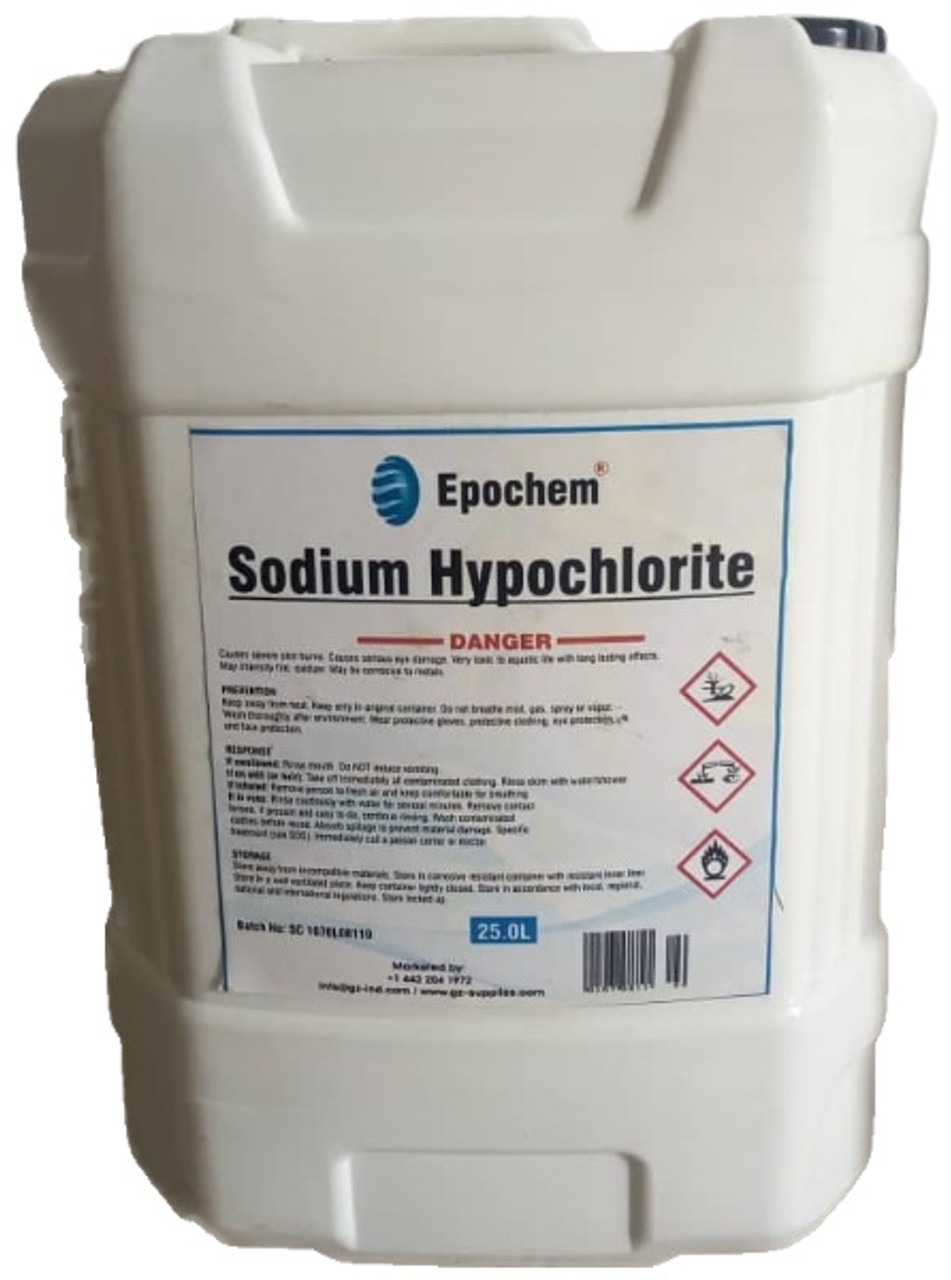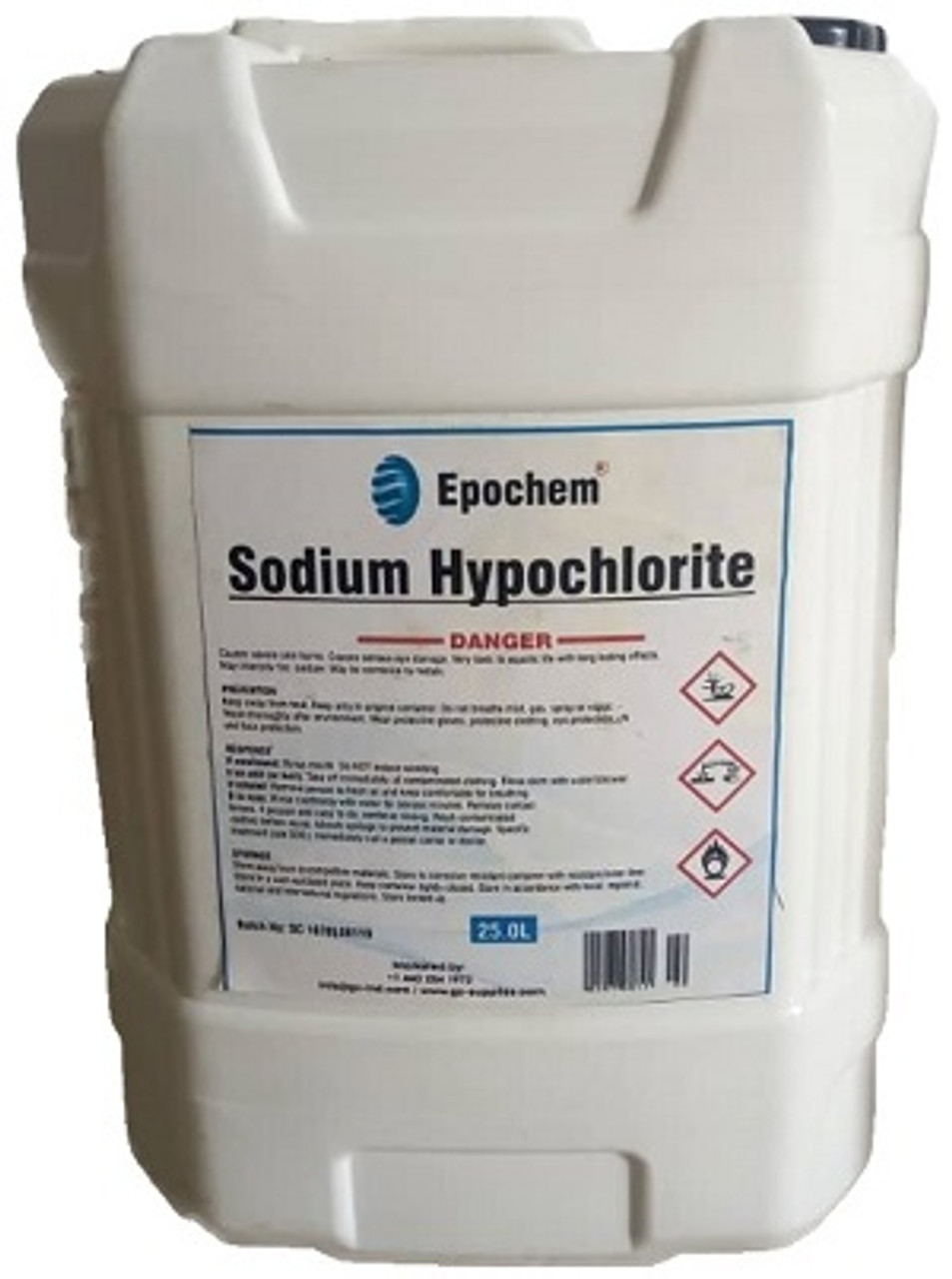Safe Handling of Sodium Hypochlorite: Dos and Don'ts
In the world of disinfectants, few compounds wield the power and versatility of sodium hypochlorite. From purifying water sources to sanitizing surfaces, its efficacy in combating pathogens is unparalleled. However, with great power comes the need for great responsibility. Safe handling of sodium hypochlorite is not just a precaution; it's a necessity. Now Let's dive deep; the Epochem Sodium Hypochlorite is a chlorine compound often used as a disinfectant or a bleaching agent. Sodium hypochlorite in 0.5% w/v solution is called Dakin's solution, and is used as an antiseptic to clean infected topical wounds. Epochem Sodium hypochlorite appears as colorless or slightly yellow watery liquid with an odor of household bleach.
When it comes to the safe handling of sodium hypochlorite, one critical factor that often goes unnoticed is proper ventilation. Inadequate ventilation can create a potentially hazardous environment, allowing harmful fumes to accumulate and pose risks to individuals working with this disinfectant. To minimize the risks associated with inadequate ventilation, it's essential to prioritize proper airflow. Adequate ventilation involves allowing fresh air to circulate through the workspace, ensuring that any potentially harmful fumes are promptly diluted and dispersed.
In this guide, we embark on a journey to understand the crucial dos and don'ts of managing sodium hypochlorite. By delving into its properties, exploring its diverse applications, and emphasizing safety practices, we empower ourselves to wield this powerful tool while ensuring the well-being of individuals and the environment.
Understanding Sodium Hypochlorite
Sodium hypochlorite, a chemical compound represented by the formula NaClO, is a powerful and versatile disinfectant with a wide range of applications. This section delves into its chemical composition, properties, and its pivotal role as both a disinfectant and a cleaning agent.
Epochem Sodium Hypochlorite
1. Chemical Composition and Properties:
Sodium hypochlorite is primarily composed of sodium (Na), chlorine (Cl), and oxygen (O). It exists as a pale greenish-yellow liquid with a distinct chlorine odor. The compound's properties stem from its ability to release chlorine, which is a potent oxidizing agent. This characteristic grants sodium hypochlorite the capacity to neutralize microorganisms by damaging their cellular structures and interfering with vital biochemical processes.
2. Role as a Disinfectant and Cleaning Agent:
Sodium hypochlorite's disinfectant properties arise from its capacity to produce hypochlorous acid (HOCl) when dissolved in water. Hypochlorous acid is a powerful antimicrobial agent that attacks the cell walls and proteins of microorganisms, rendering them inactive. This mechanism allows sodium hypochlorite to effectively eliminate a broad spectrum of pathogens, including bacteria, viruses, and fungi.
In addition to disinfection, sodium hypochlorite excels as a cleaning agent due to its oxidation capabilities. It breaks down organic materials, such as stains and debris, through chemical reactions, making it an efficient cleaner for surfaces and materials that need thorough sanitation.
Dos and Don'ts: Safe Handling Practices of Sodium Hypochlorite
A. Dos:
1. Proper Storage: Safeguarding the potency of sodium hypochlorite starts with proper storage practices. Keep sodium hypochlorite in a cool, dry, and well-ventilated area. Shield it from direct sunlight to prevent chemical degradation. Additionally, ensure it's stored away from incompatible substances that could lead to dangerous reactions.
2. Personal Protective Equipment (PPE): Prioritize your safety by wearing the right PPE. Equip yourself with gloves, safety goggles, and aprons to shield your skin and eyes from potential exposure. These protective measures act as a barrier against contact with concentrated sodium hypochlorite, minimizing the risk of harm.
3. Dilution: Dilution is key to safe usage. Always follow recommended guidelines for dilution, which help reduce the concentration of sodium hypochlorite to manageable levels. When mixing, remember to add sodium hypochlorite to water rather than the other way around. This prevents splashing and ensures a safer mixing process.
4. Mixing: When combining sodium hypochlorite solutions, choose well-ventilated areas for the mixing process. Adequate ventilation minimizes the concentration of fumes, reducing the risk of inhalation. Importantly, refrain from mixing sodium hypochlorite with other chemicals unless you have expert guidance, as this can lead to hazardous reactions.
5. Application: Applying sodium hypochlorite safely is equally crucial. Employ caution and utilize appropriate tools when handling diluted solutions. Follow recommended application methods specific to your task. Adhering to proper techniques ensures effective disinfection without compromising safety.
Epochem Sodium Hypochlorite
B. Don'ts:
1. Direct Contact: Steer clear of direct contact between your skin and concentrated sodium hypochlorite. Avoid any accidental splashes onto your skin or eyes. In the event of contact, promptly rinse the affected area with water to minimize potential harm.
2. Mixing with Other Chemicals: Refrain from mixing sodium hypochlorite with other chemicals without expert guidance. Incompatible chemicals can trigger unsafe reactions, endangering both your well-being and the environment. Stick to recommended practices to avoid hazardous situations.
3. Inadequate Ventilation: Stay out of confined spaces or poorly ventilated areas when handling sodium hypochlorite. These environments can lead to the accumulation of fumes, putting you at risk of inhaling toxic gases. Prioritize well-ventilated spaces to ensure your safety.
4. Ingestion and Inhalation: Never consume or inhale sodium hypochlorite. Keep solutions and containers away from your mouth and nose to prevent accidental ingestion or inhalation. Adhering to this guideline minimizes the risk of harmful health effects.
By adhering to these dos and don'ts, you establish a strong foundation for safe and effective handling of sodium hypochlorite. Following these guidelines ensures that you harness its disinfection potential while safeguarding your health and the environment.
The Risks and Hazards of sodium Hypochlorite
While sodium hypochlorite offers remarkable benefits, it's essential to acknowledge the potential risks and hazards associated with its mishandling. This section addresses these concerns, shedding light on its corrosive nature and the health hazards that improper handling can pose.
1. Corrosive Nature:
Sodium hypochlorite is corrosive, which means it has the capacity to damage or destroy materials it comes into contact with. This property is due to its oxidizing nature, which can lead to the degradation of metals, plastics, fabrics, and other substances. Consequently, proper storage, handling, and application are crucial to prevent damage to surfaces and equipment.
2. Potential Health Hazards:
Improper handling of sodium hypochlorite can result in potential health hazards. When exposed to concentrated solutions or fumes, individuals may experience respiratory irritation, coughing, and discomfort. Prolonged or intense exposure to sodium hypochlorite can lead to skin and eye irritation, burns, and even chemical burns in severe cases.
It's vital to exercise caution and follow safety guidelines to minimize exposure. Wearing appropriate personal protective equipment (PPE), such as gloves and safety goggles, is essential when working with sodium hypochlorite.
Emergency Procedures when handling sodium Hypochlorite
When working with chemicals like sodium hypochlorite, it's crucial to be prepared for unexpected situations. Accidental exposures, spills, or injuries can happen despite our best efforts. In this section, we delve into the steps to take in such emergencies and stress the importance of swift and informed actions.
1. Accidental Exposure, Spills, or Injuries:
Immediate Response: In case of accidental skin contact, immediately rinse the affected area with plenty of water for at least 15 minutes. For eye exposure, flush the eyes with water for 15 minutes and seek medical attention. If sodium hypochlorite is ingested, do not induce vomiting. Instead, drink water or milk and seek medical attention immediately.
Spills: In the event of a spill, isolate the area if possible to prevent further exposure. Absorb the spilled liquid using appropriate absorbent materials. Ensure proper ventilation to disperse any fumes that may have been released.
2. Contacting Medical Professionals or Emergency Services:
If exposure, spill, or injury occurs and symptoms appear severe or persistent, it's crucial to seek medical attention promptly. Medical professionals can assess the situation and provide appropriate treatment. In case of inhalation of fumes or ingestion, contacting a poison control center or seeking medical assistance is essential to mitigate potential health risks.
Training and Education of handling Sodium Hypochlorite
1. Importance of Proper Training:
Handling sodium hypochlorite safely requires proper training. Individuals responsible for its use should undergo comprehensive training on its properties, safe handling practices, and emergency procedures. Training equips individuals with the knowledge and skills necessary to minimize risks and respond effectively in challenging situations.
2. Understanding Safety Data Sheets and Chemical Labels:
Safety data sheets (SDS) and chemical labels provide critical information about sodium hypochlorite, including its hazards, safe usage guidelines, and emergency response instructions. It's imperative to thoroughly understand the information presented in these documents. SDS offer insights into first aid measures, protective equipment, and procedures to follow in case of exposure or spillage.
Proper Handling Practices: Training ensures that individuals are well-versed in dos and don'ts, enabling them to handle sodium hypochlorite with confidence and proficiency. Knowledge of safe storage, correct dilution techniques, and appropriate application methods helps prevent accidents and ensures efficient disinfection.
Creating a Culture of Safety: Education and training foster a culture of safety within organizations and communities. It instills a sense of responsibility and promotes awareness about the potential hazards associated with sodium hypochlorite. This culture of safety extends beyond personal protection to safeguarding the environment and the well-being of all stakeholders involved.
Conclusion
In wrapping up our exploration of sodium hypochlorite's safe handling, it's clear that responsible practices are pivotal. By adhering to the dos and don'ts outlined here, we minimize risks while maximizing benefits. Safe storage, proper PPE, diligent dilution, and cautious application safeguard us and our environment.
Effective disinfection relies on informed application. Safeguarding ourselves and those around us requires adherence to safety protocols and swift response to emergencies. Responsible use extends beyond personal protection—it's a commitment to community well-being.
Our journey through sodium hypochlorite's nuances underscores the importance of safety in chemical handling. By embracing these practices, we contribute to a culture of well-being, ensuring that our efforts toward effective disinfection are always grounded in care, awareness, and responsibility.
Readers also like…
Epochem Sodium Hypochlorite Disinfectant Best use
Epochem Sodium Hypochlorite Best Environmental Disinfectant in Nigeria
SODIUM HYPOCHLORITE IS EFFECTIVE IN FIGHTING THE CORONA VIRUS
Sodium Hypochlorite in Food Industry: Ensuring Safety and Hygiene
Sodium Hypochlorite in Water Treatment: A Powerful Solution for Safe and Clean Water
Recent Posts
-
Comparative Analysis: Distilled Water vs. Tap Water for Battery Use
Key takeaway:The purity of distilled water helps in maintaining the optimal chemical balance within …26th Apr 2024 -
A Complete Buyer’s Guide to Welding Machines in Mangoro, Ikeja, Lagos
IntroductionThere are currently numerous dealers of welding machines in Lagos, but selecting th …25th Apr 2024 -
Where to buy welding equipment in Nigeria Near me
When you're in need of welding equipment in Nigeria, finding a reliable source is crucial to en …22nd Apr 2024






